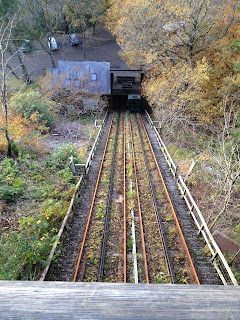We learned that CAT had been running since 1973. During the 70's people feared for a third world war and began to realise that supplies would eventually run out. Fossil fuels would not be around forever and the world was using too much oil. Influential books were also published during this era, such as Silent Spring by Rachel Carson, which describes how DDT (a pesticide) enters the food chain and accumulates in the fatty tissues of animals - including human beings. Suddenly, people were more concerned about environmental issues than they ever had been before. CAT founded their site during this time to promote sustainable alternatives.
Jo Gwillim joked in his presentation that CAT was a "museum of mistakes". He said that they had learn by doing what alternative materials were successful and which were not. Most notable was when CAT decided to build one of their buildings from timbre, a good natural material. However, it takes a lot of energy to dry timbre and so they they decided to use the timbre without drying it, in order to save energy. Yet when the timbre eventually dried, it shrunk and changed shape, resulting in a cracked roof! Jo also said that they had used wool (a natural material) to insulate the walls of their building. Yet when it rained, water got into the wool, causing it to dampen, which made the entire building smell of dead sheep! Lovely. So CAT have had to learn from their mistakes through experimentation and seem to be doing this a lot more successfully now.
At the moment, CAT runs courses and provides educational insight into sustainability and helping the environment. It has turned from an experimental place into an educational place. One of their goals is to help achieve a 100% cut of carbon emissions, which will address all parts of society.
After the talk, we explored the grounds.
A large wind turbine found on the site! This is certainly different to your traditional windmill yet seemed to be working just as successfully.
Solar panels had been used on various buildings around the site. This was actually a electricity-generating photovoltaic (PV) roof. The left hand side was installed in 1997 and the right hand side in 2007. The individual panels are not sitting on the roof - they actually are the roof! This saves material and cost. A sign nearby showed: 1) How much energy it was currently generating, 2) How much energy had been generated since October 2006 and 3) Greenhouse Gas emission saved. Seen below:
These results were definitely an eye opener.
An innovative use of material (above). These coloured pencils were made of simple, thick twigs. The production of the pencils is therefore much lower and quicker, which saves energy. I think that they look quite attractive too, especially when tied in bundles.
Another innovative use of material were these socks, which were made out of bamboo! This was something I had never even considered possible, so these were interesting to view. They felt like high-quality socks.
This display showed rockwool, which is cheaper and better suited to places that could get damp like sheep's wool. The sign explains by insulating your conservatory this conserves energy.
Unique transportation up to the site.
Map of site.
Interior of shop. All the products found in the shop were eco-friendly and unique in appearance. It was fun looking at innovative use of materials I would have never thought of before.
The most curious thing I saw! At first I wasn't sure what this is. When I read the sign is explained that this was a hub (the bit the blades are attached to) from an NM72 wind turbine. When the 35 m blades are attached, this has a rotor diameter of 72 metres and the output from a turbine of this size would be 2.75 megawatts.
References:
http://www.cat.org.uk/index.html
http://www.nrdc.org/health/pesticides/hcarson.asp












No comments:
Post a Comment